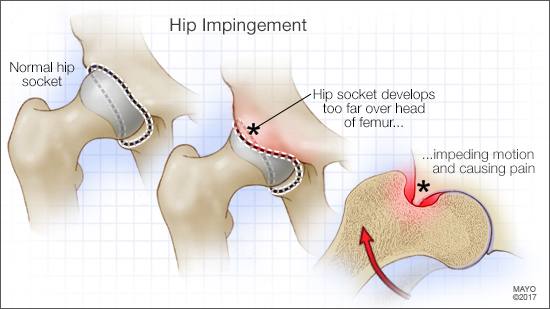-
Mayo Clinic Q and A: Understanding and treating hip impingement
 DEAR MAYO CLINIC: What causes hip impingement, and will the pain worsen over time? How is it treated?
DEAR MAYO CLINIC: What causes hip impingement, and will the pain worsen over time? How is it treated?
ANSWER: Hip impingement can happen for a number of reasons. If left untreated, the pain and other symptoms it causes may get worse as damage to the hip joint increases. Treatment for hip impingement depends largely on a person’s individual circumstances. Generally though, treatment options range from managing symptoms with medication and physical therapy in milder cases to surgery in more severe cases.
Hip impingement is a broad term used to describe conditions in which the ball and socket of the hip joint don’t fit together properly. It’s usually due to one of three main causes. First, the socket, also called the acetabulum, may develop abnormally as a child grows. This can lead to a condition known as acetabular retroversion, in which the socket grows too far over the front of the ball, or femoral head, of the hip joint.
Second, abnormal bumps called cam lesions can develop on the head-neck junction of the hip ball. Current research suggests that these cam lesions develop during adolescence, often when the growth plates are open. Participating in certain physical activity may lead to conflict between the ball and the socket, stimulating the bone to grow and create the cam lesion. Third, an abnormal twist in the thigh bone, or femur, called femoral retrotorsion can lead to hip impingement. All three of these situations can combine in varying degrees to create the impingement.
Hip impingement can lead to loss of internal rotation of the hip. That triggers pain in the groin area during or after flexing the hip, such as when you run, jump or sit for long periods of time. Loss of hip internal rotation can be a good screening tool for possible hip impingement in adolescents.
Over time, impingement of the hip may tear the labrum — a fibrous ring of cartilage surrounding the hip socket. When the labrum is torn, it can cause hip pain. Hip impingement also may damage the protective cartilage that covers the ends of the bones in the joint, called articular cartilage. That can wear down the cartilage over time and eventually make it deteriorate completely — a condition known as hip osteoarthritis. Osteoarthritis can trigger hip pain, tenderness, stiffness and loss of flexibility. If nothing is done to correct severe hip impingement, these conditions likely will continue to worsen. As they do, hip discomfort, pain and other symptoms increase.
As each case of hip impingement is unique, treatment must be individualized to each patient. Multiple factors are considered when designing a custom treatment plan for patients, including their symptoms and desired activity level, hip bone anatomy, overall body mechanics and range of motion, as well as the amount of damage done to the labrum and articular cartilage.
In mild to moderate cases of hip impingement, symptoms may improve with nonsurgical treatment, such as activity modification, pain medication, physical therapy and corticosteroid injection. In more severe or complex cases, arthroscopic or open surgery may be used to reshape the bones, repair the labrum and treat articular cartilage damage.
If you are diagnosed with hip impingement, consult with a physician who specializes in orthopedics to review your options and decide on a treatment plan that best suits your situation. — Dr. Aaron Krych, Orthopedic Surgery, Mayo Clinic, Rochester, Minnesota







